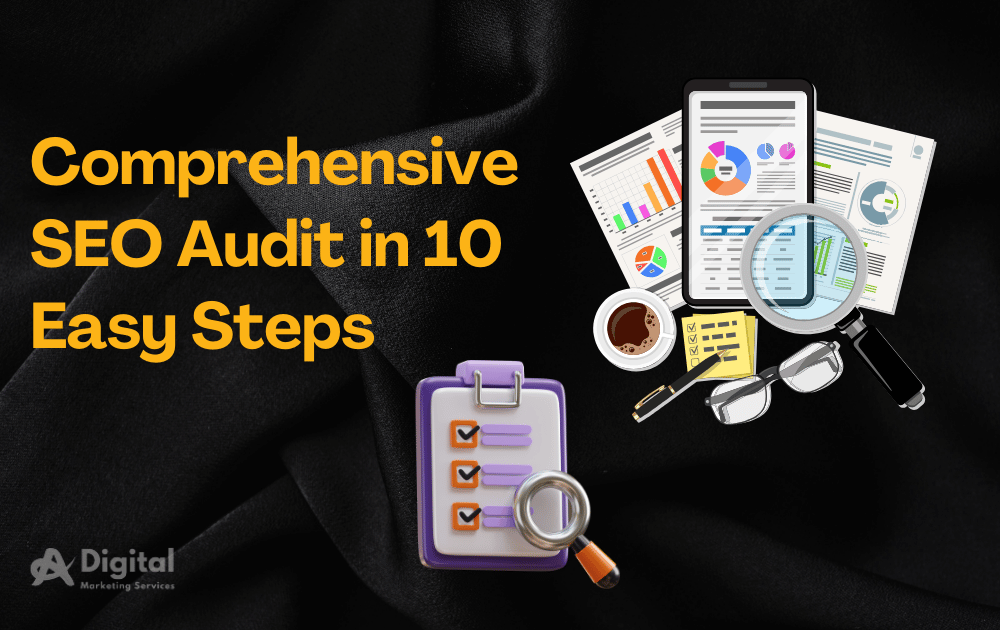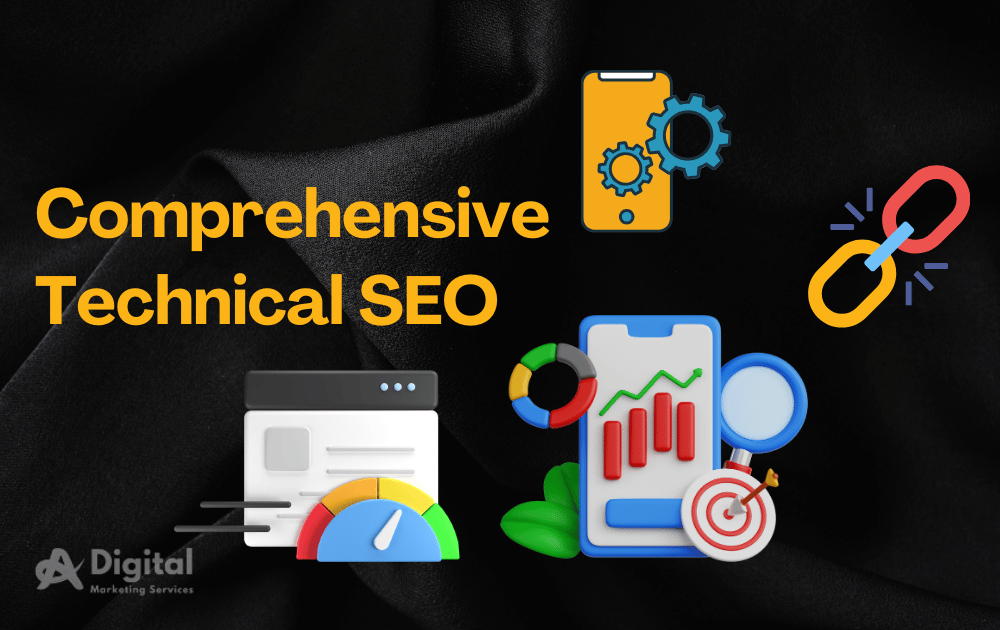
Whenever you want your website to appear in Google search, it has to be optimized for SEO. One of the effective ways to achieve that is by running an Comprehensive SEO audit. This will provide you with specific things on the site that work and do not, and how to fix them.
In this post, we will outline how to do a full SEO audit in 10 simple steps. These steps are even easy enough for newbies in the field of SEO and, if followed, will enrich your website rankings.
Step 1: Check Your Website’s Comprehensive Technical SEO

Technical SEO deals with how easily crawled and indexed your site is by the search engine. First, your website should be mobile-friendly, making sure it opens up quickly without broken links. You can have your Page Speed Insights using tools by Google or Screaming Frog.
Mobile-Friendliness: More and more people are starting to use their phones for browsing. It is essential that your site looks great and works properly on mobile phones.
Page Load Speed: If your website is slow, people won’t stick around. Take advantage of the many online tools available that can help you check load times and ensure that your site comes on in quickly.
Broken Links: Ensure all links on your website work. If you have broken links, you are running the risk of search engines having problems crawling your website.
Pro Tip: A fast, functional website creates a better user experience, which is fundamental for SEO.
Step 2: Run the Structure and Navigation Analysis of Your Website

The structure of your website should be such that it should be easily navigable for users and search engines. A properly structured site with a well-organized hierarchy enables the search engines to understand the context of your content.
There needs to be logical flow with regard to structuring of your categories, subcategories, and pages.
Internal Linking: Internal links are those which connect different pages on your website. This keeps users engaged and helps search engines discover more content.
Breadcrumbs: This is a navigational system that shows what path the user has taken to land on whatever page they are currently on. This is super useful for usability and SEO.
Pro Tip: The easier it is to get around your site, the longer people will stay on your site, and the better that reflects on your bounce rate and SEO.
Step 3: Comprehensive SEO Audit On-Page

On-page SEO refers to the things on and about your site that you actually have control over. Review the following:
Title Tags: Your page titles must be unique, descriptive, and contain your main keyword.
Meta Descriptions: The meta descriptions should be irresistible, with keywords inside that beckon users to click on your link.
Headings: Headings like H1, H2 will break up your content into parts and organize your content in such a way that readers and search engines understand.
Alt Text for Images: All images should have descriptive alt text with relevant keywords included.
Keywords: your main keywords need to be present in your content, but not so that it’s overstocked.
Pro Tip: actually care for serving users. The Search Engines love high-quality, substantial content, and will reward ranking accordingly.
Step 4: Evaluate Content Quality
Your content needs to be unique, useful, and relevant for your target audience. Consider the following features:
Freshness: Is your content current? Do not let obsolete information lower your rank.
Relevance: Let your content speak for what the user wants to see.
Length: Although longer content generally tends to perform better in search rankings, it needs to make sense and not be filled with fluff.
Pro Tip: Using tools like Google Analytics can help find which of your pages are performing well. Take the worst performing and update/optimize.
Step 5: Check for Duplicate Content for Comprehensive SEO Audit
Duplicate content can really confuse the search engines and will negatively affect your SEO. Use tools like Copyscape or Siteliner to identify issues and correct duplicate content problems.
Avoid Duplicate Pages: If you have numerous pages of similar content, you might want to consider merging them or using canonical tags to specify which one the search engines should index.
Pro Tip: Keep your content unique if you don’t want the search engines to penalize you.
Step 6: Backlinks Analysis

Backlinks are a strong ranking factor that means links from other websites leading to your website. Run a backlink profile with the help of Ahrefs or Moz:
Quality of Backlinks: Not all backlinks are created equally. Focus on acquiring links from reputable, high-authority websites.
Anchor Text: Anchor text refers to the text used in the backlinks and should be relevant to your content.
Remove Bad Backlinks: Utilize Google’s Disavow Tool to eliminate poor quality or spammy backlinks.
Pro Tip: A good backlink profile tells the search engines that your website is credible and worthy of trust.
Step 7: Analyze Your Website’s User Experience (UX)

User experience is an important aspect when looking at it from the point of view of both SEO and customer satisfaction. Here are some important areas to consider:
Design: Is your website eye-catching to your target audience and user-friendly?
Readability: Are your contents easy to read and comprehend by users?
CTA: Are there clear calls-to-action that will guide users along your site?
Pro Tip: A good user experience often means longer visits and lower bounces, helping your SEO.
Step 8: Run a Local SEO Check

If you have a local business, then you must focus on local SEO. Check:
Google My Business: It should be listed and verified.
NAP Consistency: Your name, address, and phone number must be consistent across all platforms.
Local Keywords: Use location-based keywords in your content.
Pro Tip: A strong local SEO presence helps you show up in “near me” searches, driving more local traffic to your site.
Step 9: Analyze Competitor SEO
Follow your competition. SEMrush allows you to look at who their competitors are, identify keyword gaps, backlinks, and new content opportunities.
Identify keywords that your competitors are ranking for that you aren’t.
See what topics your competitors cover, and how you can create better content on similar topics.
Pro Tip: Understanding your competitor’s strategy will provide an opportunity to outrank them.
Step 10: Monitor and Measure Your Comprehensive SEO Audit Performance
SEO is a continuous process. You will have to check your performance periodically. Through Google Analytics and Google Search Console, you can monitor:
Organic traffic: how many people reach your site via search engines?
Bounce rate: do users leave your site right away? This might show poor content or navigability.
Keyword Rankings: This shows the effectiveness of your rankings and thereby requires you to adjust the strategy to fit more effectively.
Pro Tip: Regular checking on your metrics will help you always be one step ahead of competitors and adjust your SEO strategy accordingly.
If You want to your website Comprehensive SEO Audit in free then (Click this Blue text).
Conclusion:
Performing a thorough SEO audit does not seem such a daunting task when one breaks it down into these relatively simple 10 steps that will go a long way in systematically improving the performance of your site. Remember, SEO is somewhat an ongoing process; it is always in motion, so one has to continually monitor and optimize the website for good results.
Give time to technical SEO, the quality of the content, user experience, and backlinks, and you will go a long distance in improving the search rankings of your website and increasing site traffic.

Add a Comment